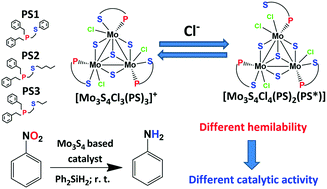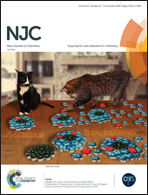Hemilability of phosphine-thioether ligands coordinated to trinuclear Mo3S4 cluster and its effect on hydrogenation catalysis†
Abstract
Ligand-exchange reactions of [Mo3S4(tu)8(H2O)]Cl4·4H2O (tu = thiourea) with (PhCH2CH2)2PCH2CH2SR ligands, where R = Ph (PS1), pentyl (PS2) or Pr (PS3), afford new complexes isolated as [Mo3S4Cl3(PS1)3]PF6 ([1]PF6), [Mo3S4Cl3(PS2)3]PF6 ([2]PF6) and [Mo3S4Cl3(PS3)3]PF6 ([3]PF6) salts in 30–50% yields as the major reaction products. The crystal structures of [1]PF6 and [2]PF6 were determined by X-ray diffraction (XRD) analysis. Each of the three phosphine-thioether ligands is coordinated in a bidentate chelating mode to a different molybdenum atom of the Mo3S4 trinuclear cluster; herein, all the phosphorus atoms of the phosphino-thioether ligand are located trans to the capping sulfur (μ3-S). A second product that forms in the reaction of [Mo3S4(tu)8(H2O)]Cl4·4H2O with PS1 corresponds to the neutral [Mo3S4Cl4(PS1)2(PS1*)] complex. Its XRD analysis reveals both bidentate (PS1) and monodentate (PS1*) coordinating modes of the same ligand. In the latter mode the phosphine-thioether is coordinated to a Mo atom only via the P atom. All compounds were characterized using 1H and 31P{1H} NMR spectroscopy, electrospray-ionization (ESI) mass spectrometry and cyclic voltammetry (CV). Reactions of [1]PF6, [2]PF6 and [3]PF6 with an excess of Bu4NCl in CD2Cl2 were followed by 31P{1H} NMR spectroscopy. The spectra indicate equilibrium between cationic [Mo3S4Cl3(PSn)3]+ and neutral [Mo3S4Cl4(PSn)2(PSn*)] (n = 1, 2) species. The equilibrium constants were determined as 2.5 ± 0.2 × 103 M−1, 43 ± 2 M−1 and 30 ± 2 M−1 (at 25 °C) for [1]PF6, [2]PF6 and [3]PF6, respectively, indicating quantitative differences in the hemilabile behaviors of the phosphino-thioether ligands, depending on the substituent at the sulfur. Clusters [1]PF6, [2]PF6 and [3]PF6 were tested as catalysts in the reduction of nitrobenzene to aniline with Ph2SiH2 under mild conditions. Significant differences in the catalytic activities were observed, which can be attributed to different hemilabile behaviors of the PS1 and PS2/PS3 ligands.



 Please wait while we load your content...
Please wait while we load your content...